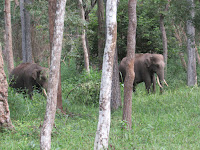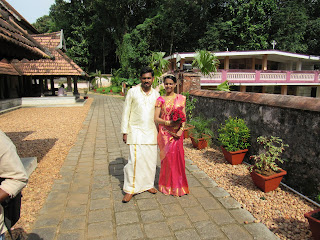To all intent and purpose there are no rules of the road. To
the new arrival travelling by road in Kerala it seems that chaos reigns with
vehicles occupying every space on the road in a very haphazard fashion. In fact,
there are highway regulations (which I know from having to learn them for my
driving licence), but it seems that for most Indians once the driving test has
been passed all the rules are conveniently forgotten! Instead driving is akin
to participating in a chaotic game of highway chess.
There are essentially four things to watch out for when driving:
1. Pot Holes – these can suddenly appear even in what seems to be a good road surface. To save their tyres and suspension everyone swerves to avoid them even if this means driving on the wrong side of the road.
2. Road Humps – why ‘sleeping policemen’ are needed in areas where roads are congested is a mystery as traffic moves so slowly especially during the rush hour periods at the start and end of the working day. Although they are supposed to be marked most are not and can take the driver by surprise and give their passengers a nasty jolt!
3. Traffic Lights – some of the major road junctions have them, usually positioned above the lanes, but there is no advance warning that they are there and some can be very dim to see.
4. Traffic Police – many road junctions have one or more uniformed policemen to control the flow of traffic. Unlike the bobbies who used to wear white gauntlets to direct traffic in England, the Keralan policeman uses flailing arms and whistles to stop and start vehicles.
There are essentially four things to watch out for when driving:
1. Pot Holes – these can suddenly appear even in what seems to be a good road surface. To save their tyres and suspension everyone swerves to avoid them even if this means driving on the wrong side of the road.
2. Road Humps – why ‘sleeping policemen’ are needed in areas where roads are congested is a mystery as traffic moves so slowly especially during the rush hour periods at the start and end of the working day. Although they are supposed to be marked most are not and can take the driver by surprise and give their passengers a nasty jolt!
3. Traffic Lights – some of the major road junctions have them, usually positioned above the lanes, but there is no advance warning that they are there and some can be very dim to see.
4. Traffic Police – many road junctions have one or more uniformed policemen to control the flow of traffic. Unlike the bobbies who used to wear white gauntlets to direct traffic in England, the Keralan policeman uses flailing arms and whistles to stop and start vehicles.
Given these ‘hazards’ the cautious person drives at a
leisurely pace watching out for vehicles to front and rear and to left
and right. Mirrors are essential, as would be eyes on the back and sides of the
head.
Apart from pot holes, vehicles move out to avoid pedestrians
and the many animals that share the roads – cows, goats, buffalo, stray dogs. Horns
are essential to announce to anybody and everybody that you are there, and
particularly when overtaking other vehicles; passing anything that breathes; or
on blind bends. In fact, some drivers consider it obligatory to sound the horn
continuously. The exception is late at night when full beam is used but without
bothering to dip for oncoming vehicles!
Overtaking slow moving vehicles seems mandatory. In doing so
you have to move out, look for a clearish gap in the oncoming traffic, check
nothing is coming up behind or to either side and then go for it. But then a vehicle
may swerve out or a pot hole may suddenly appear so giving a wide berth is
essential. Even then another vehicle may
overtake you meaning there can be 3 or 4 vehicles abreast of each other, which
can be scary when there is traffic approaching from the other direction!
Roundabouts exist but there is no real concept of ‘give way to
the right’ and more often or not vehicles will go around them in the wrong
direction! At road junctions drivers have to watch out for scooters,
motorbikes, rickshaws and indeed any vehicle joining the road from any side.
There is no concept of stopping first and it is assumed approaching traffic
will slow down or swerve around them.
Additionally,
vehicles will turn around at will, usually involving pulling into the centre of
the road before doing so. On dual carriageways U turning vehicles force
vehicles to slow down and change lane to allow them to join. As the use of
indicators or hand signals is minimal the use of the horn is essential.
Road signs are limited to some of the major junctions and in
many urban and rural areas street signs can equally be non-existent. Sat Nav helps
but is not always accurate and signal can be lost in mountain areas. Even so it
is better than trying to ask directions without any Malayalam. Petrol stations
are frequent, and all charge roughly the same price although diesel is cheaper than
petrol. There is no concept of self service and attendants fill the fuel for you - just
like they used to do in the UK fifty years ago.
Basically, driving on Indian roads is like a game of
draughts or chess. You can move in any direction where there is an empty space
if it gives you a millisecond of advantage – and this principle is adhered to by
all drivers. It is very much survival of the fittest. Tailgating is
obligatory!
The biggest menace on the roads are the buses. They are big,
solid lumps of metal that are always driven as fast as possible expecting
everyone else (sensibly) to make way for them. If they are the King of the Road
then the fleets of Toyota Innova seven seater cars favoured by tour companies
are the Queens of the Road as they sweep serenely along. Alongside them are the
hordes of auto-rickshaws that really are the Knights of the Road, picking their
way through the traffic making the most of their mobility if not their speed.
It would be nice to term the heavy goods vehicles, with
their brilliantly colourful decorations, as the Bishops of the Road but in reality,
they are the donkeys that plod along slowing everything up behind them. The role
is taken by the motor cars which are generally piously driven with care and attention.
The Pawns are definitely the swarms of scooters and
motorcycles that weave their way between other vehicles with impunity. They are
a sight to behold, often with a whole family of two adults and three or four
children balanced on them. The irony is that legally only the driver must wear
a crash helmet whereas their passengers do not!
With time the shock of travelling on Indian roads wears off
as you become inured to the apparent chaos. There are accidents but essentially
the ‘unwritten’ rules (based around the official ones) do work and only occasionally
is highway stalemate experienced.




























































